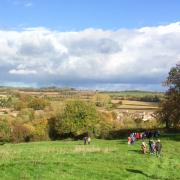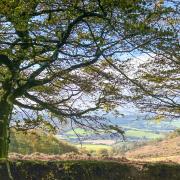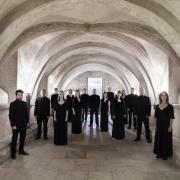Artists have spent centuries attempting to capture the light, but as this Somerset artist has proved, the only real way to capture it is to make it part of the work

Too often dismissed as decorative, the medium of glass is a feast for the eyes and the soul. Next to architecture it is the medium of choice for reflecting devotion but it is also fast finding itself into our homes - albeit on a slightly smaller scale.
Stuart Low has been working on architectural glass projects for almost three decades.
Living and working in Bristol with his artist wife and two daughters, his projects have increasingly moved out of churches and large-scale buildings to decorate our more modest homes.
"In recent years I have found making smaller work for galleries to be just as rewarding and have discovered a renewed joy in making stained glass in its fundamental form using traditional tools and materials," he says. "Working like this allows for more time in my studio, which I love, and I have found a completely new audience of people interested in my work."

The increase in art pieces and a move away from architectural commissions means more than just a variety of scale and subjects - but also the ability to develop a creative style influenced, like many artists, by his surroundings.
"I grew up in Somerset and still walk regularly on the Mendips holding a soft spot for the coastline around Devon, Dorset and Cornwall and, while my work is not connected to these places in a literal sense, topographically I do think they influence my subject matter," he adds.
"Most of my inspiration is connected to nature and places I go to for space and reflection. I enjoy noticing seasonal changes in the landscape and the mood the weather has upon it, or focusing on smaller details; a feather found on a forest path, the colours in a rock pool or the plants I grow in my garden. These elements are woven into my work using bright colour, bold blues, greens and turquoise, hot pinks and oranges, rendered in an illustrative style and balanced with playful abstracted marks and textures. The key for me is remaining true to myself and following a personal approach to design and subject matter. In this way I hope to change the perception that many people have of stained glass, to ask them to look again and enable them to experience work that is traditionally crafted with a contemporary twist and spirit.
"My approach to each commission has been different both in design content and also my chosen methods of fabrication, often transcending leaded glass and utilising modern construction processes."

Stained glass is created differently from the fused glass you might more commonly see created using panels or 3D objects. While in fused glass, different colours are melted and fused to each other, stained glass is more like painting. Traditional stained glass will feature outlines using lead to enable the subject matter to be visible from a distance. The glass itself differs as stained glass tends to use hand blown glass sheets.
"Sketchbooks are an important part of my practise and I try to use them on a weekly basis," he explains. "Some contain notes and observational drawings of things I find interesting, in others I like to develop ideas in a playful way for translating into glass. I enjoy working directly with brushes and layers of acrylic paint, over painting and introducing collaged elements until a drawing arrives at a place that strikes a chord with me.
Stuart will transpose the design into a working drawing, cut each shape from sheets of handblown glass or from cullet saved over years of making and then begin glass painting. Illuminated on a lightbox, the coloured shapes are laid out flat, drawn lines from the design and washes of dark paint can be added and removed, scraffitoed out and modulated with textures to reveal the glow of colour beneath. The pieces of glass are then fired in the kiln to fix the paint before being leaded into the final window using lengths of lead cane and solder to finish the work.
This complex process can take many weeks or months, but for Stuart it is part of the pleasure of creating the work.
"I enjoy each of these stages for their individual pace, the delight of washing paint onto coloured glass with a flat haik brush, the rhythmic pace of leading up a window on the bench using hammers and horseshoe nails to secure the work as it grows and the smell of the final cementing process. "Nothing can be rushed, care and concentration is required throughout. It's therefore hugely satisfying at the end to hold a piece of new work up to the light for the first time, clean, sparkling and complete."
Stuart's work can be found in a number of galleries across the UK. For more information, visit stuartlow.co.uk.



























